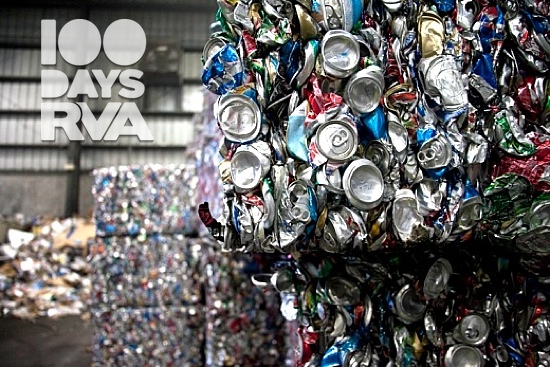Day #059: The competition between recycling and refuse
City refuse collection is excellent. In fact, it’s so good that it’s limiting recycling buy-in.

Inspired by Michael Bierut’s 100 Day Project, 100 Days to a Better RVA strives to introduce and investigate unique ideas to improving the city of Richmond. View the entire project here and the intro here.
- Idea: Improve the convenience of recycling while degrading the quality of city refuse services in order to boost recycling participation and promote conservation.
- Difficulty: 3 — There are myths surrounding recycling in Richmond, and people are typically unwilling to sacrifice services. This idea is a little more practical than Day #039: Pre-sorting trash, and landfill mining and reclamation.
City refuse collection is the pinnacle of Richmond city services. For $17.50 per month, my three-resident household gets a supercan (they’ll pick up four!), weekly pickup, and free bulk waste. We don’t even have to roll the can to the curb1 and payment is part of the water bill so extra checks and stamps aren’t a concern. City refuse collection is awesome–actually, it’s a little too awesome.
Recycling benefits society in ways that reach well beyond the borders of Richmond. It reduces tons of material entering the waste stream, reduces the methane created by landfills, and lowers material demands which helps maintain low product prices. Richmond is working hard to boost buy-in and participation in recycling, but meaningful change won’t occur until the incentives are stronger. This can happen in two ways: decrease the opportunity cost of recycling or increase the opportunity cost of substitutes (refuse collection).2
The city currently offers recycling to ~60,000 households and five drop-off locations, and charges $1.67 per month. Despite only being a fraction of the out-of-pocket cost of refuse, participation has stagnated recently and residents still heavily favor trash. In 2008, residents recycled 6,903 tons while sending 88,004 tons to the landfill.3 The best ways to boost participation would be with marginal costs on trash volume while reducing the inconvenience of recycling.
Large buildings and commercial spaces
City recycling in Richmond is limited to buildings with four units or less and it skips businesses. ~42% of residents live in multi-unit structures, and businesses are thousands of city parcels. The city is brainstorming ways to bring this large neglected population into the recycling net.
Pay as you throw (PAYT)
Throwing trash away has negative externalities. Moving from a fixed cost system to a marginal cost system internalizes some of those externalities and incentivizes conservation. This system is suggested in the RVA Sustainability Plan and would likely require buying special bags that cost a premium. This is an unfortunate hassle, and it encourages people to illegally dump waste, but the idea of creating marginal costs for waste is fundamental to a sustainable future.
Recycling convenience
A city refuse “supercan” can hold more empty beer cans and pizza boxes than the wildest 21 year-old can even imagine. Meanwhile, CVWMA recycling bins are small, lack wheels, and don’t have lids to keep materials from blowing into the street. The city should boost ownership of 96-gallon recycling bins; it would cost $3.5 million to give every household in Richmond a 96-gallon recycling bin.4 That money could come from savings from refuse collection.
Frequency of service
It’s tough for “is it a blue week or a red week?” to compete with the out of sight out mind convenience of alley pick up. Increasing the frequency of recycling or decrease the frequency of trash pick up could boost volume. While a 10-day cycle sounds inconvenient, email/text reminders largely mitigate the challenges.
Alley pickup isn’t an option right now unfortunately as recycling trucks are larger than the city’s refuse collection trucks. In the long run, this seems like an essential change for Richmond.
— ∮∮∮ —
The RVA Sustainability Plan already suggests a few of these ideas but they won’t be as effective as long as refuse collection is so cheap and convenient. Fortunately, the city is going through a waste characterization study and the community has several strong personalities promoting sustainability.
Despite the difficult climate, Richmond has made meaningful progress on recycling over the last decade. It’s important that the community continues to make progress because a sustainable and resilient Richmond will be better today and in the future.
Alicia Zatcoff (RVA Sustainability Director) and Kim Hynes (Executive Director of CVWMA) contributed to this article; however, the entirety of this article does not reflect their individual beliefs.
Love this idea? Think it’s terrible? Have one that’s ten times better? Head over to the 100 Days to a Better RVA Facebook page and join in the conversation.
Photo by: Mel Korban
- In a household of three 22 year-old men, the value of this can not be overstated. ↩
- In a bizarre way, the city is really competing with itself. ↩
- That’s 7.3% which is well below Virginia’s 25% recycling mandate. ↩
- 1,395 households already use these bins which is impressive considering the $65 price tag. ↩
-
Recommend this
on Facebook -

Report an error
-

Subscribe to our
Weekly Digest





Notice: Comments that are not conducive to an interesting and thoughtful conversation may be removed at the editor’s discretion.
I would love to see the recycling of #5 plastic.